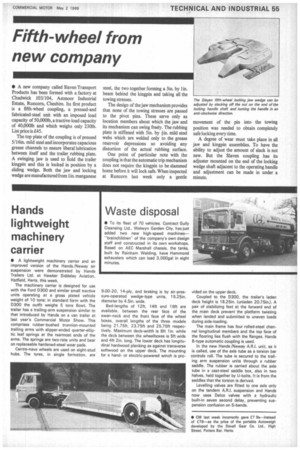Hands lightweight machinery carrier
Page 57

If you've noticed an error in this article please click here to report it so we can fix it.
• A lightweight machinery carrier and an improved version of the Hands /Neway air suspension were demonstrated by Hands Trailers Ltd. at Hawker Siddeley Aviation, Hatfield, Herts, this week.
The machinery carrier is designed for use with the Ford D300 and similar small tractive units operating at a gross plated vehicle weight of 10 tons; in standard form with the D300 the outfit weighs 5 tons 6cwt. The trailer has a trailing-arm suspension similar to that introduced by Hands on a van trailer at last year's Commercial Motor Show. This comprises rubber-bushed trunnion-mounted trailing arms with slipper-ended quarter-elliptic leaf springs at the rearmost ends of the arms. The springs are two-rate units and bear on replaceable hardened-steel wear pads.
Centre-nave wheels are used on eight-stud hubs. The lyres, in single formation, are 9.00 20, 14-ply, and braking is by air-pressure-operated wedge-type units, 15.25in. diameter by 4.5in. wide.
Bed-lengths of 12ft, 14ft and 16ft are available, between the rear face of the swan-neck and the front face of the wheel boxes, overall lengths of the three models being 21.75ft, 23.75ft and 25.75ft respectively. Maximum deck-width is 8ft 1in. while the deck between the wheelboxes is 5f1 wide and 4ft 2in. long. The lower deck has longitudinal hardwood planking as against transverse softwood on the upper deck. The mounting for a handor electric-powered winch is pro vided on the upper deck.
Coupled to the D300, the trailer's laden deck height is 18.25in. (unladen 20.75in.). A pair of stabilizing feet at the forward end of the main deck prevent the platform twisting when landed and submitted to uneven loads during side-loading.
The main frame has four rolled-steel channel longitudinal members and the top face of the flooring lies flush with the flanges. Hands B-type automatic coupling is used.
In the new Hands /Neway A.R.I. unit, as it is called, use of the axle tube as a torsion bar controls roll. The tube is secured to the trailing arm suspension units through a rubber saddle. The rubber is carried about the axle tube in a cast-steel saddle box, also in two halves, held together by U-bolts. It is from the saddles that the torsion is derived.
Levelling valves are fitted to one axle only on the tandem A.R.I. suspension and Hands now uses Delco valves with a hydraulic built-in seven second delay, preventing suspension confusion on S-bends.




















































































































































































































